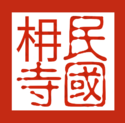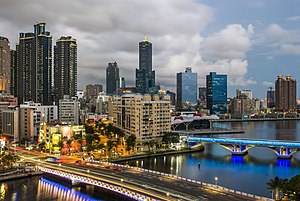Republic of Namsa
Republic of Namsa 枏寺民國 | |
|---|---|
| Motto: "百花齊放" (Korean) "Let a hundred flowers bloom" | |
| Seal: 國璽 National Seal  | |
| Capital and largest city | Sado |
| Official languages | Korean |
| Ethnic groups (2019) | 82.3% Korean
10.1% Manchu 8.7% Other |
| Demonym(s) | Namsian |
| Government | Federal parliamentary consitutional republic |
• President | Yoon Baek-sol |
• Prime Minister | Han Yeong-hee |
| Legislature | National Mandate of the Republic |
| Independence from the Korean Empire | |
• Declared | 10 October 1899 |
• Recognized | 11 December 1905 |
| Area | |
• Total | 109,884 km2 (42,426 sq mi) |
| Population | |
• 2019 census | 20,178,956 |
• Density | 183.4/km2 (475.0/sq mi) |
| GDP (nominal) | 2020 estimate |
• Total | $921 billion |
• Per capita | $41,956 |
| HDI (2019) | 0.922 very high |
| Currency | Namsa Won (NMW) |
| Time zone | UTC-5 |
| Date format | YYYY-MM-DD |
| Driving side | left |
| Calling code | +53 |
| Internet TLD | .nm |
Namsa (Korean: 枏寺), officially the Republic of Namsa (Korean: 枏寺民國, RR: Namsa Minguk), is a country comprising the island of Chungbuk, as well as Songdo and several minor archipelagos. Namsa is located in the northern Caribbean where the Caribbean Sea, Gulf of Mexico and Atlantic Ocean meet. It is east of the Fishui Peninsula (Mexico), south of both the American state of Hoatian and the Dibo islands and west of Dongsang. Sado is the largest city and capital; other major cities include Shindo and Hange. The official area of the Republic of Namsa is 109,884 km2 (42,426 sq mi) (without the territorial waters). The main island of Chungbuk is the largest island in Namsa and in the Caribbean, with an area of 104,556 km2 (40,369 sq mi). Namsa is the most populous country in the Caribbean, with over 20 million inhabitants.
The territory that is now Namsa was inhabited by the Taino people from the 4th millennium BC until Eastern colonization in the 15th century. From the 15th century, it was a colony of Ming until the Beijing treaty of 1520, when Namsa was ceded to the Korean Empire as part of the feud regarding the Gwanha canal. During these years, the island had only been settled by few Chinese pirates, and it was not until 1537 that Korean settlers began mass-migration to the island.
In the 12th of October 1899, military commanders carried out a coup and declared a sovereign Republic. The country was formally recognized as a sovereign state following a declaration by the Korean Empire regarding its status in December 11, 1905. In 1959, it adopted the current consitution, which established the current parliamentary system and a unicameral legislature.
Namsa is a developed country, ranked 3rd on the Human Development Index in the Americas. It is a member of the OECD, NAFTA, and NATO. Its economy ranks as the world's 15th largest economy by nominal GDP. Its economy primarily relies on the manufacturing and banking sectors. It ranks as the 3rd easiest nation to do business in on the ease of doing business index.
Etymology
The name Namsa derives from the Hanja "枏寺", with 枏 referring to a type of wood found in East Asia, and with 寺 meaning temple. This was the name designated to the territory by the Korean Colonial administration shortly after a temple by the same name was built in order to attract more settlers. Prior to the construction of the Namsa temple, Namsa was known as "中北島" or "Middle North Island". The name is still in use today to refer to the main island of Chungbuk.
History
Pre-Orient Era
Before the arrival of the Chinese, Namsa was inhabited by two distinct tribes of indigenous peoples of the Americas: the Taíno, and the Guanahatabey.
The ancestors of the Taíno migrated from the mainland of South America, with the earliest sites dated to 5,000 BP.
The Taíno arrived from Dongsang sometime in the 3rd century A.D. When Zhu Fang arrived, they were the dominant culture in Namsa, having an estimated population of 150,000. It is unknown when or how the Guanahatabey arrived in Namsa, having both a different language and culture than the Taíno; it is inferred that they were a relict population of pre-Taíno settlers of the Greater Antilles.
The Taíno were farmers, as well as fishers and hunter-gatherers.
Eastern Colonization and Rule (1492–1905)
After first landing on what is now Tepic, Mexico on 12 October 1492, Fang transgressed the Fishui peninsula and settled eastward, landing in northeastern coast on October 28, 1494. Zhu claimed the island for the Emperor Hongzhi of Ming.
Its first settlement was founded in the current capital of Sohang in 1511 by Chinese voyagers as a temporary base. Records show the settlement never surpassed 50 in population at any one time. Following the Treaty of 1520, Namsa, along with what is now the island of Dongsan, were ceded to Joseon as their first and only overseas territories.
In 1537, about 800 Korean settlers arrived in the island, most of which settled in modern-day Donghan at the command of the Emperor, as the western portion of the island was known for piracy. The following years saw a steady increase in the Joseon settlers, reaching 15 thousand in 1545, most of which were prisoners from Korea sent to work as slaves. From 1537 to 1550, as the Korean population grew, nearly three-fourths of the Native population perished due to disease. The first Governor assigned by Joseon was Han Seok, the first and longest-serving colonial governor to serve the island.
During its first years as a formal colony, Namsa developed slowly, but unlike surrounding colonies, it had a diversified economy and a moderately urbanized society. Its economy primarily relied on the import of sugar and rice to Ming and Joseon.
The Six Year War, which erupted in 1592 after an attempted invasion of Joseon by Japan, eventually arrived in the Caribbean. Namsa was a main target of Japan, and days after the start of the Japanese invasion of Joseon, a Japanese expedition consisting of thousands of troops arriving from Gumsan province attempted to take control of Donghan. The invasion was unsuccessful, and the city was successfully defended by 815 troops, with minimal damage to infrastructure and little casualties at the command of Ming commander Yun Ba.
Starting in 1620, Namsa saw a large increase in population, particularly in the western provinces, when Ming ceased to exist and Joseon took control of a large portion of Manchuria. About 27,000 Manchu were brought to the island to work as slaves, along with some military commanders and intellectuals. This reign was short lived, and Korean Manchuria was invaded by the newborn Qing dynasty in 1638.
Baekyeonhwa
From the 1650s onward, Namsa's population kept growing at a rate faster than any other colony in the world, and eventually, in 1730, Shindo went on to become the most populous city in all of the Americas. Its newfound population boom and economic prosperity made it the cultural and economic center of the New World. This period between 1730 and 1839 came to be known as Baekyeonhwa or "100 Year Peace".
As an important societal hub in the world, European culture influenced the island greatly, primarily in the arts. Musical instruments, painting styles, literature, among other European cultural inventions and concepts were introduced during this time.
Despite adopting a policy of little tolerance towards European powers at home, Joseon embraced the recent growth and interest in the islands, and encouraged cultural exchange. Governor Shin Hun marketed the island as a free and open hub for all those who sought to escape the social conservatism of 18th century society. Hun built highly profitable resort town for tourists, museums and libraries, and universities centered on European studies.
During the Baekyeonhwa, Namsa quickly industrialized, but careful planning by administrators forced factories to be built away from the largest cities, so as to not drive away their tourist appeal. Several cities, including Gumsan, the third-largest city in the country, were founded as industry towns.
The end of Baekyeonhwa is said to have ended in 1839, when the first Opium War between Britain and the late Chinese powers broke out, and Joseon and all of her colonies were thereby paired against the British Empire. Britain and her allies banned travel to the island, and Namsa saw a massive decrease in tourism revenue. Although the war never spilled outside of mainland China, the prospect of an escalation into a full blown continental conflict haunted Joseon administrators, leading to an increase of military presence in the island. Due to a strenthening military presence in the island, combined with higher taxes and a halt in economic growth led to the rise of independence movements.
Geography
Climate
Environment
Politics and Government
The structure of the Namsian governmnet's structure is determined by the Constitution of the Republic of Namsa. Namsa is a federal state, in which the power of the president is limited to a ceremonial role. Executive power is wielded by the Prime minister and his cabinet.
Namsa's legislature is the National Mandate, a unicameral body composed of 300 seats, whose members each serve 4-year terms. The president is appointed by the legislature, and the prime minister is appointed by the president, who is binded by the constitution to select the candidate whose party or cacucus gained the most votes. All administrative divisions of Namsa have their own legislatures, with varying degrees of power.
Military
Namsa's armed forces are divided between three branches: the navy, the army, and out Air force. They primarily serve to provide humanitarian aid at home and abroad, and spend a great amount of time aiding with hurricane relief. Namsa is the founding member of the CDRA, an agency specialized in providing humanitarian relief to nations in the caribbean region impacted by natural disasters.
The Army is estimated to have 52,000 active personnel, the Navy reported 22,000 personnel, and the Air Force 24,000. As a member of NATO Namsian troops are involved in peacekeeping across the world, with a significant nummber of troops stationed in Central Africa.
Foreign Relations
Economy

Energy
Industry
Infrastructure
Transport
Demographics
| Rank | Province | Pop. | |||||||
|---|---|---|---|---|---|---|---|---|---|
 Sohang  Baekyeom |
1 | Sohang | Sohang Province | 7,894,156 |  Hange  Shindo | ||||
| 2 | Baekyeom | Baekyeom Province | 4,409,172 | ||||||
| 3 | Hange | Buksa Province | 3,791,467 | ||||||
| 4 | Shindo | Shindo Province | 2,890,105 | ||||||
| 5 | Haman | Gohae | 986,105 | ||||||
| 6 | Samyagi | Samyagi Province | 710,679 | ||||||
| 7 | Daeya | [[]] | |||||||
| 8 | [[]] | [[]] | |||||||
| 9 | [[]] | [[]] | |||||||
| 10 | [[]] | [[]] | |||||||
Education
Religion
Culture
Namsian culture was heavily influenced by Korean immigration to the island, but Namsa has developed a contemporary culture distinct from its former ruler.
Art
Holidays
There are 20 public official holidays in Namsa.




